Featuring a full-length forecastle deck and rigged to pump pelagic fish over the stern, Serene LK 297 was the first of its class in the world when delivered to Whalsay skipper Bobby Polson and partners by West Contractors AS of Ølensvåg, Norway in August 2009. David Linkie looks back on Serene’s second trip, fishing herring on the Turbot Bank east of Peterhead
A hesitant early September dawn was breaking over the North Sea when Serene’s Furuno FSV-30 low-range sonar indicated the first mark of herring 1,500m fine on the port bow. It was shortly before 6am on the Turbot Bank, a traditional late-summer herring ground some 40 miles east of Peterhead.
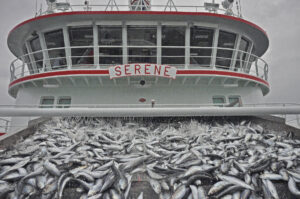
Herring flowing from Serene’s C-Flow seawater separator towards the forward RSW tanks.
Although Serene had taken her first shot of herring – 260t of big (350g) fish – off Balti in Shetland waters five days previously, Bobby Polson, who was the only Scottish pelagic skipper at sea in early September after the other boats had caught their quota allocation, had decided to head south from where several Scandinavian boats were reported to have taken decent shots in the previous 72 hours.
With the Dutch freezer trawler Atlantic Princess towing down the port side, Bobby Polson and Tommy Eunson, who was tracking the marks back to Serene using the Furuno FSV-84 medium-frequency sonar, took the decision to continue searching and give Serene’s crew a while longer in their cabins.
After a few more promising marks were detected and plotted in the next 45 minutes, Serene’s crew were swiftly on deck following the ‘away to shoot’ call on the internal intercom.
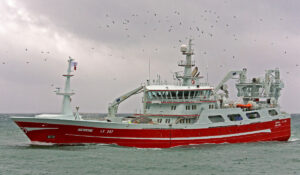
Serene approaching Peterhead with 850t of herring aboard.

Serene’s crew tying off the tail and life lines as the split rope comes off the lower net drum.
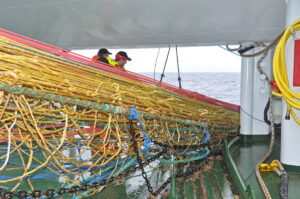
Hauling the wings onto the drum through the single stern opening on Serene’s full-length forecastle deck.
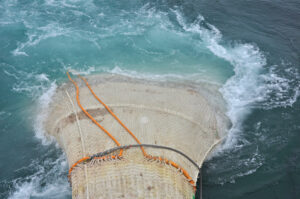
375t of North Sea herring are hauled towards Serene’s stern as the tailend splitter lies slack atop the bag.
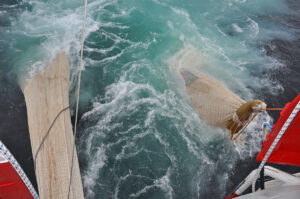
Taking the tailend up to the port side of the transom.
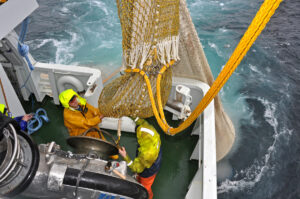
Crewmen on Serene prepare to attach the tailend to the inlet of the Karm fish pump.
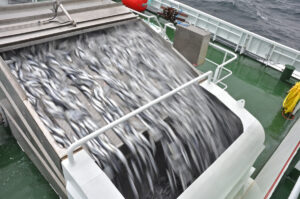
Pumping in full swing.
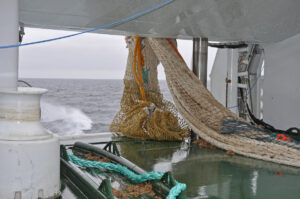
Starting to outhaul the bag of Serene’s 1,100m Selstad herring trawl…

… before the taper section of the nets approaches the stern.
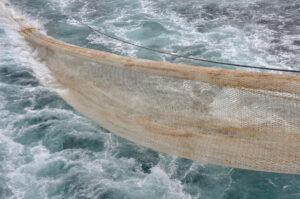
The tailend rope runs out parallel to the brailler.
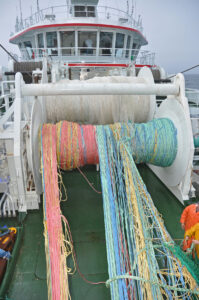
The colour-coded wings of the midwater trawl come off the drum.
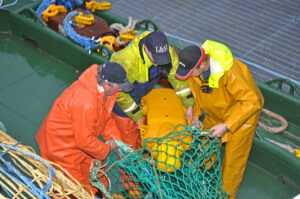
Securing the Simrad net sounder into its pocket above the headline.
It was only the second time that the crew had shot the herring trawl with intent, but after the bag was outhauled as Serene powered round to port, it was quickly shot away, as the brailler started to be run off the drum following the final call from the wheelhouse.
With Serene designed for pumping pelagic fish aboard over the stern, rather than forward of amidships on the starboard side, the arrangement of the safety lines on the midwater trawls was slightly different to those the crew had worked previously. The main difference was that although a midline was in place on the brailler, it was only expected to come into play when handling bigger hauls of mackerel in poor weather, when it would be used alongside the main dog rope and tail line.
After the main dog rope and tailend line were clipped onto the aft splitter, the colour-coded (red/yellow – port upper/lower; green/blue – starboard equivalent) wings of the Selstad 1,100m midwater herring net started to disappear into Serene’s wake. Shooting in only 58m of water, just one set of 1.2t toe-end weights were clipped onto the toe ends of the trawl before the 90m sweeps were spooled off the lower net drum.
As the toe-end weights dropped some 6m into the water – illustrating the significantly increased freeboard Serene had as a result of its full-length forecastle deck, from which the midwater gear was worked through a single central opening – most of the crew moved up to the boat deck under the trawl gantry, ready to connect the 100m 36mm-diameter Dyneema sweeps to the trawl doors with the usual combination of messengers, Y-pennants and backstrops.
Serene was using a set of Polar BAT hydro-wing midwater trawl doors to spread the herring trawl. With a surface area of 13m2, the 3,300kg BAT hydro-wing doors were the first series of trawl doors designed in cross-curved shape that were supplied by Polar Fishing Gear of Iceland. In addition to the four vertical adjustments available to shackle the trawl wire to the forward inner surface of the door (the second-highest was used), the angle of attack of the doors could be increased or decreased by connecting the sweeps to any one of six horizontal adjustment holes arranged along the top and bottom edges of the doors (the third in from the net was used).
Fifteen minutes after the tailend of the net was outhauled, Serene was towing at 4.6 knots in 58m of water with 80% pitch on the blades of the 4,000mm-diameter propeller. The Karm 3001 autotrawl system was indicating a wire tension of 13t with 200m of warp shot.
After towing south for 15 minutes back to the area where fish had been plotted earlier, the low-frequency sonar picked up a mark 2,000m slightly to starboard of Serene. Following an appropriate heading alteration, the mark was tracked back towards Serene on the display screen of the medium-frequency sonar before it started to appear under the boat, as shown on the Furuno FCV-30 and 120L 38/88/200kHz and Simrad ES-60 120/200kHz sounders.
With skipper Bobby Polson constantly keeping an eye on the lead of the trawl wires astern to ensure that the net was aligned correctly, while compensating for the fact that the Furuno CI-68 BB tidemeter (244kHz) was showing an S to S/W tide run at the selected depths of 10/25/40m, the fish were subsequently shown entering the mouth of the trawl during one sweep of the Simrad FS-70 trawl sounder.
Towing in shallow water, the footrope of the trawl was on the bottom. A number of northeast Scotland skippers who had been aboard to look over Serene while the vessel was berthed at Peterhead and pass over readings had assured Bobby Polson that this was fine ground, providing he did not go too far south. The net sounder was indicating a net opening of 50m x 20m and a wide oval shape that showed the gear to be performing efficiently.
A second smallish mark quickly followed the first into the Selstad trawl, as a result of which the first two Simrad PI32 catch sensors were triggered. With Serene’s sonars displaying no further activity, heave mode was selected on the Karm autotrawl system, as a result of which the Y-pennants were soon being used to transfer the strain of the sweeps from the doors to the net drum.
Thirty minutes later, prime North Sea herring were flowing down the C-Flow separator into two forward RSW tanks. Less than two hours after shooting away, Serene began searching again, with the crew estimating that a ‘heavy 200t’ of herring had been pumped aboard.
Within 20 minutes, the crew were given further opportunity to familiarise themselves with the slightly different working arrangements on the new Serene, as the midwater gear was smoothly shot away again after a bigger mark was located and plotted.
Successfully guided into the mouth of the net, this mark fulfilled expectation, as the density of herring was sufficient to mask out the sonar beam from showing the port profile of the trawl. A similar echo soon appeared to starboard on the long-range sonar, which immediately led to a quick helm alteration. While this proved sufficient to ensure that some fish from the mark were guided into the mouth of the net, the net sonar subsequently showed the main weight of fish sliding down outside the starboard wing, after the mark appeared to split just ahead of the doors.
Even though it was a case of win some, lose some, three catch sensors were on, so after a 35-minute tow, the crew were waiting under the trawl gantry for the doors to surface astern. Hauling yielded slightly more (275t) than the first of the morning.
Although Serene had now taken around 500t from two hauls in just over four hours of fishing in the same area, no further marks were located when skipper Bobby Polson started searching again. Having just appeared in the area, the Danish midwater trawler Ruth had shot further east, just a couple of miles north of where Atlantic Princess was lying.
Calling up the Atlantic Princess skipper on the VHF resulted in Serene steaming four to five miles into the southeast, on hearing encouraging news of ‘big and small marks, on and off the bottom around me’.
At the same time as the Dutch freezer trawler start shooting away, Serene picked up a couple of promising marks on what had now become an extremely wet day, which later resulted in extensive flooding and road closures in northeast Scotland.
As Serene settled into the third tow, the crew were called to the messdeck to enjoy a fine selection of chunky braised chops, tatties and fresh veg that Allen Anderson had prepared and cooked in the time he was not on deck in the previous two hours. However, the appearance of several successive marks meant that the apple pies and ice cream remained untouched, as with four eggs off, the trawl was hauled again after being down for an hour.
It was therefore no surprise when the net drum started to dry up a considerably fuller brailler, the tail end of which was smoothly hauled aboard and attached to the fish pump. Twenty-five minutes later, skipper Bobby Polson set a course of 283° for Peterhead. Serene steamed the 39 miles at 15 knots with 79% propeller pitch, resulting in an engine loading of 70%.
After months of waiting to see how Serene would perform on her first full fishing trip, the skipper and crew’s enthusiasm in taking the first steps on the long road towards proving the fishing credentials of their new vessel, together with their relief that much-discussed ideas were being proved viable, were a pleasure to experience.
Even when Serene was asked to hold her position two miles off Peterhead to the north of the leads for almost an hour, in order to allow a cruise ship to leave the port, it did not dampen the spirits of the crew, especially as six road tankers were already lined up along the Albert Quay. This ensured that Serene could start to land as soon as the fishery officers had come aboard to dip the tanks and confirm a total of 850t of herring with an average fish weight of 260g.
By using the secondary discharge outlet of the fish/seawater separator and the third vacuum tank located within the shelterdeck as well as the main double vacuum pumping system, Serene was able to land to Lunar tankers and the Fresh Catch quayside pipe during the night, in order to minimise landing time.
In 2017, eight years after this trip, Serene was sold to Henning Veibust of Ålesund and renamed Havstaal, as skipper Bobby Polson and partners waited to take delivery of a new 82m midwater trawler from Karstensens shipyard. The new build was based on similar working arrangements to those that had proved consistently successful on her predecessor, with the deck machinery again being located at boat deck level.
Stern pumping arrangements prove highly efficient
As Serene’s lower 111t net drum took the strain and started to dry up what appeared to be a reasonable haul of herring from the first tow of the morning, the Dyneema tailend line attached to the tail splitter was clipped into the messenger rope of the 50t tailend winch, which was situated aft of the split trawl winch on the wider port side of Serene’s boat deck.
Leading through a hanging block on the port side of the trawl gantry directly above the fish pump, the rope quickly brought the tail/codend up towards the underside of the gantry. As the aft section of the brailler followed the tailend round to the port corner of Serene’s stern, the brailler formed a fairly tight bight astern of Serene, which continued to go ahead, ensuring that the dried-up section of the brailler ahead of the fish was out of the water and fully controlled.
Within three minutes of stopping to dry up the brailler with the net drum, the lifter section of the brailler was clamped in position over the 20in inlet of the new design of Karm fish pump, which was capable of delivering up to 30t of pelagic fish per minute. As the Dyneema choker line tied just forward of the tailend splitter rings was pulled clear, the arm of the Karm crane was lowered down until nearly touching the fish pump, before the lifting hook was clipped onto a short becket.
With the crane pulling the fish pump away to port clear of the hull side, the tailend splitter rope was slacked back as the bag was lowered back into the water. At the same time, the 20in-diameter fish hose was wound off the hydraulically operated storage reel. After swinging the pivoted top section of the bulwark rail to port, two crew guided the fish hose into its rectangular opening, in which it was securely located when the top section, which contained nylon guides for the hydraulic pipes used to operate the fish pump, was locked in its closed position again.
With 60m of 5.5mm-walled fish hose wound off the storage reel, a short (2m) section of rubber hose was clamped in place to connect the main fish hose through the fish pump reel to the 40m length of 20in-diameter stainless steel pipe mounted under the boat deck, in which fish were pumped forward to the C-Flow separator unit.
As the tailend splitter rope continued to be paid out at the same time as the fish pump was lowered by the crane winch, the codend was taken astern by Serene’s forward movement as the brailler straightened out again astern.
A few minutes after hydraulic oil started to be delivered along the hoses to the pump motor, the previously flat fish hose filled out as seawater started to be pumped aboard.
While adjusting the pressure of oil flowing to the pump, at the same time as communicating with the crewman controlling the tailend winch and crane, Leonard Polson quickly gave the thumbs-up when herring started to flow past the transparent inspection window arranged in the first 1m section of the fixed delivery pipe directly above the pump controls.
By providing full vision of the rate at which fish are being pumped, the viewing section ensured that the relative positions of the pump, tailend and brailler, together with the optimum pump speed, rate of flow and mix of fish/seawater being pumped aboard, can be adjusted continually during pumping to maintain maximum efficiency and delivery rates. Such relatively small ideas illustrated the amount of thought and forward planning that the partners had put into the development of their new vessel.
Immediately on clearing Peterhead’s breakwaters at 11pm the previous night, Serene’s engineers had pumped 1,000m3 of seawater into five of the vessel’s 10 RSW tanks. This water was subsequently chilled from an ambient temperature of 13°C to the optimum catch storage level of -2°C in six hours. This rapid rate of largescale cooling showed the capability of the two MMC Tendos ammonia-based refrigeration plants, which delivered 2.1mKcal of cooling per hour.
This ensured that as herring started to flow down the forward section of Serene’s C-Flow fish/seawater separator system before being directed into two of the forward tanks, their body temperature would quickly be lowered, in order to achieve optimum catch quality and eventually maximum fillet yield. After pelagic fish and seawater entered the C-Flow separator just above the level of the forecastle deck, the flow was directed upwards, during which time most of the seawater fell away from the fish. Any remaining water was drained away through the holes of the stainless steel grid as fish fell downwards into mini reception hoppers forward and aft. This arrangement ensured that pelagic fish received maximum benefit from the pre-chilled seawater.
Hydraulically operated sliding flaps in the bottom of the hoppers arranged at each end of the wide separator slides allowed the engineers in the pump control room to direct fish into any combination of RSW tanks. The number of tanks brought into play at any one time was dependent on the quantity of fish in the brailler, although usually at least two tanks were filled simultaneously.
The presence of a full-length forecastle deck above the tank tops meant that for the first time on a British or Irish pelagic vessel, crewmen responsible for checking the amount of fish in the tanks, etc, could so in the safety of the ’tweendeck space above the shelterdeck, without the risk of being washed around the deck of a fully loaded vessel lying broadside to the weather while other crewmen took the pump back aboard.
Twenty minutes after being lowered into the sea, the Karm fish pump was being lowered into its secure storage frame, after 225t of herring had been pumped aboard from the first haul. This rate of pumping was maintained for the next two hauls: 275t were taken aboard in 25 minutes after the second tow, while the 350t third haul was delivered to the RSW tanks in less than 30 minutes.
While Serene’s crew were fully aware that they would continue to be on a fairly steep learning curve for some time before becoming totally au fait with the different working arrangements, they were already gaining in confidence, knowing that when put to the initial test, the theory was proving correct and practical. Inevitably, fine-tuning in terms of adjusting the positioning of the splitter’s tailend lines, etc, on both the herring and the mackerel trawls would be carried out over time, as is commonplace on any new vessel.
The significance of the aft pumping initiative on Serene is shown by the fact that similar systems have become the norm on the majority of new midwater trawlers built in the past 11 years.








